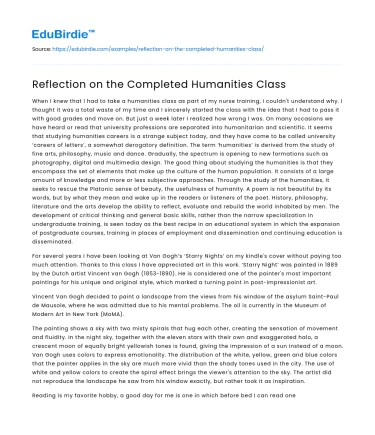When I knew that I had to take a humanities class as part of my nurse training, I couldn't understand why. I thought it was a total waste of my time and I sincerely started the class with the idea that I had to pass it with good grades and move on. But just a week later I realized how wrong I was. On many occasions we have heard or read that university professions are separated into humanitarian and scientific. It seems that studying humanities careers is a strange subject today, and they have come to be called university ‘careers of letters’, a somewhat derogatory definition. The term ‘humanities’ is derived from the study of fine arts, philosophy, music and dance. Gradually, the spectrum is opening to new formations such as photography, digital and multimedia design. The good thing about studying the humanities is that they encompass the set of elements that make up the culture of the human population. It consists of a large amount of knowledge and more or less subjective approaches. Through the study of the humanities, it seeks to rescue the Platonic sense of beauty, the usefulness of humanity. A poem is not beautiful by its words, but by what they mean and wake up in the readers or listeners of the poet. History, philosophy, literature and the arts develop the ability to reflect, evaluate and rebuild the world inhabited by men. The development of critical thinking and general basic skills, rather than the narrow specialization in undergraduate training, is seen today as the best recipe in an educational system in which the expansion of postgraduate courses, training in places of employment and dissemination and continuing education is disseminated.
For several years I have been looking at Van Gogh’s ‘Starry Nights’ on my kindle's cover without paying too much attention. Thanks to this class I have appreciated art in this work. ‘Starry Night’ was painted in 1889 by the Dutch artist Vincent van Gogh (1853-1890). He is considered one of the painter's most important paintings for his unique and original style, which marked a turning point in post-impressionist art.
Save your time!
We can take care of your essay
- Proper editing and formatting
- Free revision, title page, and bibliography
- Flexible prices and money-back guarantee
Vincent Van Gogh decided to paint a landscape from the views from his window of the asylum Saint-Paul de Mausole, where he was admitted due to his mental problems. The oil is currently in the Museum of Modern Art in New York (MoMA).
The painting shows a sky with two misty spirals that hug each other, creating the sensation of movement and fluidity. In the night sky, together with the eleven stars with their own and exaggerated halo, a crescent moon of equally bright yellowish tones is found, giving the impression of a sun instead of a moon. Van Gogh uses colors to express emotionality. The distribution of the white, yellow, green and blue colors that the painter applies in the sky are much more vivid than the shady tones used in the city. The use of white and yellow colors to create the spiral effect brings the viewer's attention to the sky. The artist did not reproduce the landscape he saw from his window exactly, but rather took it as inspiration.
Reading is my favorite hobby, a good day for me is one in which before bed I can read one or two chapters of a book. While I read, I get transported from a day full of stress and worries to another, totally different. Reading opens the door to new scenarios to introduce myself to the skin of other characters, live other lives and learn new things. Reading a book is one of the most effective ways to cool my mind and help me sleep. Contrary to using electronic devices such as an iPad or cell phone with their bright lights, reading a book in a dim light has the opposite effect of putting my brain in sleep mode.
Taking this humanities class has made me realize how many details of everyday life are not carefully observed and how they can influence people's lives. In my field of work, it is essential that we pay attention to details, to facial expressions, to what the patient does not tell us in words, but shows us in his mood, his way of interacting, his interest or selflessness in what surrounds him. Jacobus & Martin (2018) said that “Art may help us understand the dark sides—the ugly, the painful, and the tragic”. A good nurse has to be able to see beyond the vital signs, the numbers that electronic monitors give us and radiographic results to be able to treat not only the body but also mental ailments, which often go unnoticed or are undervalued.
I gained a lot of new knowledge and enlightenment from this humanities class, and I am grateful for this opportunity.






 Stuck on your essay?
Stuck on your essay?

